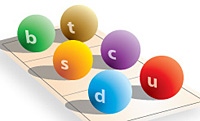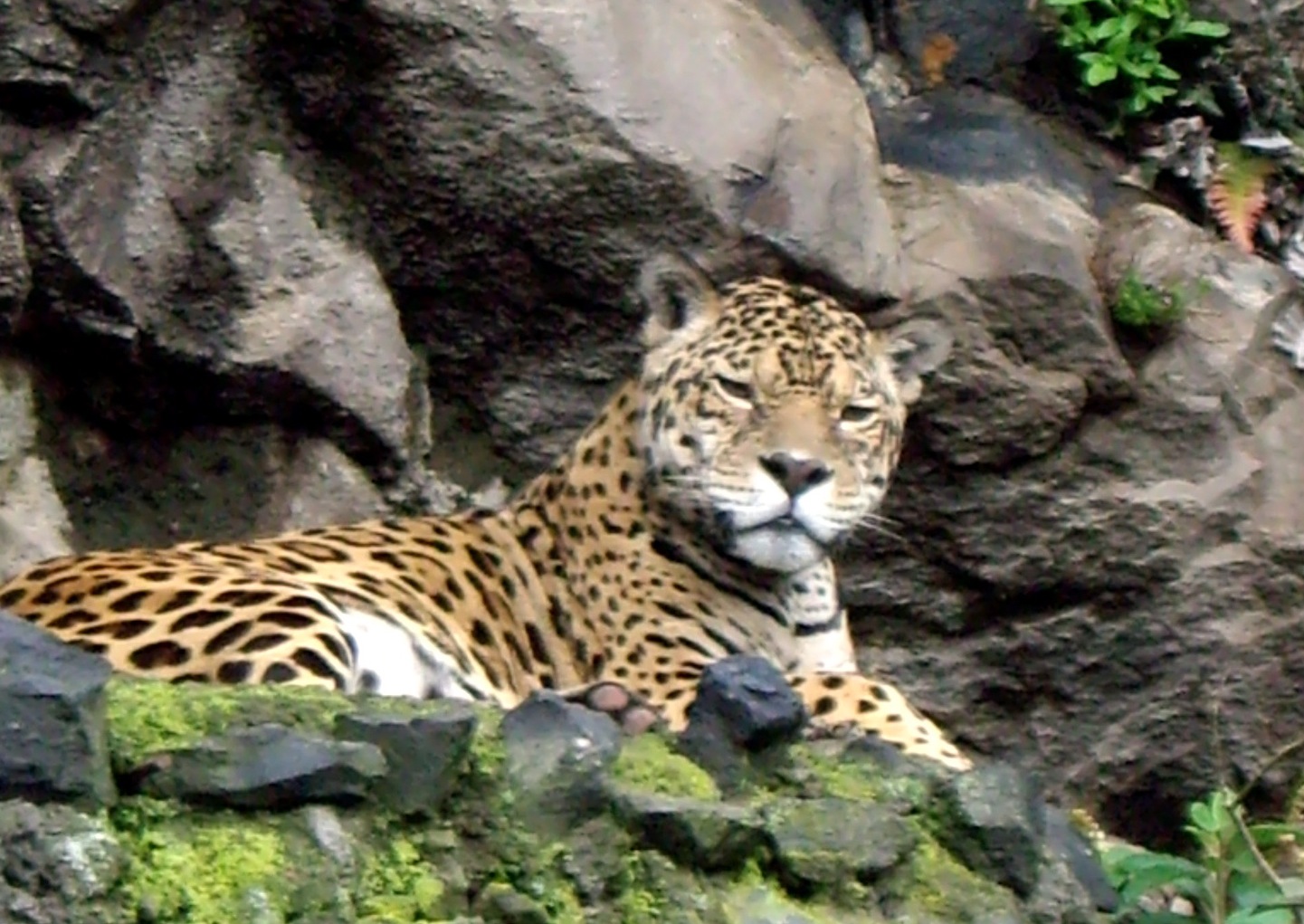Complexity II
 Gell-Mann's Opus
Gell-Mann's Opusby Murray Gell-Mann; theoretical physicist at Cal Tech
Richard Feynman | Albert Einstein | Overview | Who is he | Contents
"my aim in this volume is to present… my views on an emerging synthesis at the cutting edge of inquiry into the character of the world around us." (ix)
"my growing awareness of the fundamental laws of physics and the world we see around us." (x)
The quark and "the jaguar find themselves … at opposites"
Six flavors of quarks Jaguar in the Amazon Quantum mechanics Gravitational mechanics Physical sciences Life sciences
The Simple & the Complex
1 An Encounter in the Jungle
2 Early Light
3 Information and Crude Complexity
4 Randomness
5 A Child Learning a Language
6 Bacteria Developing Drug Resistance
7 The Scientific Enterprise
8 The Power of Theory
9 What is Fundamental?The Quantum Universe
10 Simplicity and Randomness
11 A Contemporary View of QM & classical approximation
12 Quantum Mechanics
13 Quarks and the Standard Model
14 Superstring Theory
15 Time's Arrow: Forward and Backward Time
![]()
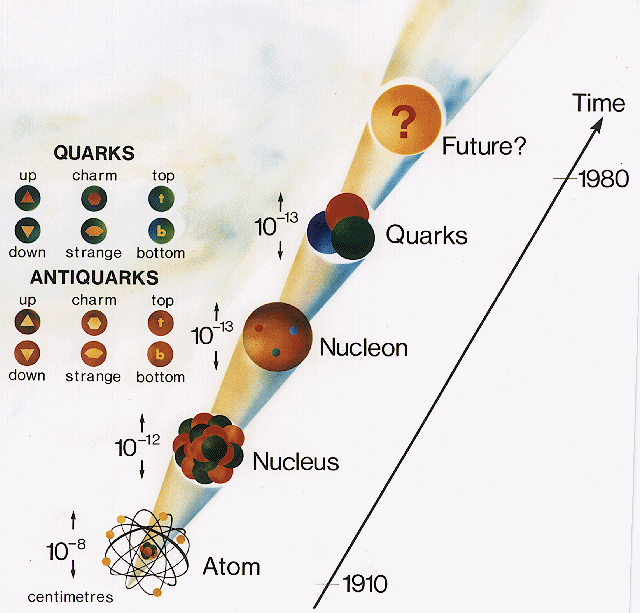
What does he mean on page 120?
Give some examples:
What is the ladder; in "up the ladder from elementary particle physics & cosmology to the realm of complex adaptive systems?"
(120)
![]()

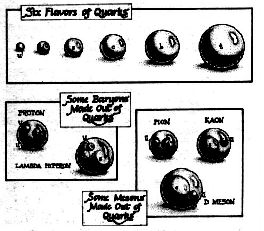 Quarks
are elementary particles, building blocks of the atomic nucleus."
(11)
Quarks
are elementary particles, building blocks of the atomic nucleus."
(11)
"…just
as the quark is a symbol of the physical laws that, once discovered, come
into full view before the  mind's analytical eye,
mind's analytical eye,
so the jaguar is, for me at least, a possible metaphor for the elusive complex adaptive system, which continues to avoid a clear analytical gaze." (12)
"It is not at all a trivial matter that there are such things as
species; and they are not just artifacts of the biologist's mind, as has
sometimes been claimed. Ernst Mayr, the
great ornithologist and bio geographer, likes to recount how, as a young
researcher in New Guinea, he counted a hundred and twenty-seven species
of birds nesting in the valley where he was working. The members of the
local tribe counted a hundred and twenty-six; the only difference between
their list and his was they lumped together two very similar species…"
(12-13)
The law of gravity; Einstein's general-relativistic theory of attraction
(16)
"A complex adaptive system acquires information about its environment and its own interaction with that environment, identifying regularities…"
(17)
"…condensing those regularities into a kind of schema or model, and acting in the real world on the basis of that schema."
(17)
Darwinian
selection among schema -- "neural Darwinism."
humans use conceptual frameworks to derive meaning from the information
we interpret around us.
(17)
a complex adaptive system perceives regularity in the data stream … condensing them into a schema
Each of the resulting schema are combined with additional information.
"What are the regularities and where do accidents and the arbitrary enter in?"
(24)
braided |
folded |
|||
plex |
plic |
|||
plek |
§
| Ways of seeing | far sighted | near sighted |
| His terminology | coarse graining | fine graining |
meaning |
rough impression | detailed impression |
Randomness
"the word 'random' means several different things"
1. meaning so irregular as to be incompressible into a smaller sequence
"incompressible strings" of numbers are random
special meaning used by computer programmers
2. generated by a chance process that is not orderly and predetermined
a gamble, proceeding by guess work, stochastic.
general meaning used by the average person
3. a table of random numbers is often generated by a pseudorandom algorithm
(48)
Monte Carlo method of sums -- a short cut for estimating large numbers
46]
"the table of random numbers is supposed to be a set of whole
numbers between one and some fixed large value, with each number chosen
by a chance process in which every number in the range has an equal probability
of occurring."
"using such pseudorandom sequences as if they were random is dangerous."
pseudorandom means containing enough regularities as to rule out chance
variations
48]
"…why algorithmic randomness or algorithmic information content does not fully match our intuitive idea of what complexity is."
"Learning or evolution requires, among other things, the ability
to distinguish, to some extent, the random from the regular. Effective
complexity is then related to the description of the regularities of a
system by a complex adaptive system that is observing it."
50)
"it is just the nonrandom aspects of a system or a string that contributes to its excessive complexity."
p. 39
on Kurt Gödel -- no consistent axioms by whose use one may determine with certainty the truth or falsity of mathematical propositions"
"… given any set of axioms for mathematics, there will always be propositions that are undecidable on the basis of those axioms. In other words, there are propositions that cannot, in principle, be shown to be either true or false."
![]()
Identifying and compressing regularities and discarding what is incidental.
"In order to discuss more fully the concept of effective complexity,, it is essential to examine in detail the nature of complex adaptive systems." (50)
"But how does a child come to know a given language, which ways of constructing a sentence are grammatical and which are not?" (52)
Noam Chomsky and his
followers conclude that the child must come already equipped at birth
with a great deal of information applicable to the grammar of any natural
human language.
"a biologically evolved innate proclivity to speak languages with certain general grammatical features, shared by all natural human languages."
language is shaped
by and reshapes the environment in which it is used.
"the child who does this (putting a grammar together from hearing
language spoken) has exhibited the first characteristic of a complex adaptive
system. (53)
provisional sets of
rules for what is grammatical and what is not."
distinguishing regularity from randomness
coherence and facticity are two different issues (53)
Since a complex adaptive
system separates regularities from randomness, it affords the possibility
of defining complexity in terms of the length of the schema used by a complex
adaptive system to describe and predict the properties of an incoming
data stream." (54-55)
Classes of regularities
schema -- models -- analogies -- metaphors
net to capture the familiar, repetitive, exotic
models of given classes (built as we do grammar)
schema emerge from exposure to massive data (55)
the "mutual information" is diagnostic of regularities
identifying and compressing regularities" (56)
experiences are stored as emotional memories that may or may not have
visceral responses in the body's musculature, neuro-stimulus mechanisms,
or behavioral triggers.
Language acquisition is the ability of a complex adaptive system to distinguish
regular patterns in the stream of stimulus converging on the receiver.
-- vocabulary -- regularizes our experience
captures a rhythm that expresses that regularity
"in other words, the system must be neither too orderly, nor too
disorderly." (59)
"When a complex adaptive system -- sorts regular from stochastic
patterns in a data stream determining to a great degree the "systematic
regularities that will be incorporated into a new schema" --"describing
the data stream."
(58)
![]()
Bacteria Developing Drug Resistance
bacteria acquire immunity over time and pass it on
"When a complex adaptive system observes another system and identifies some of its regularities, the algorithmic information content of the data stream coming from the observed system is expressed as the sum of two terms: the apparently regular information content and the apparently stochastic information content." (60)
"The whole of the Algorithmic Information Content is recognized as
the product of chance."
effective complexity is "the apparently regular portion" of
a data stream (60)
"it has been
genetically programmed as a result of biological evolution. All organisms
have such programs." (61
"But biological evolution itself can also be described as a complex
adaptive system, even in the humblest organisms." (61)
balance between individual learning (acquired traits) & biological inheritance. (61)
Bacteria developing drug resistance …"In a sense, the larger eddies gave birth to smaller." (64)
"In the course of biological evolution, random changes take place in the genotype from generation to generation, They contribute, along with the accidents of development that occur in a given generation " (65)
"The distribution of genotypes in the population is thus the result
of chance combined with natural selection."
natural selection works on the sequence of nucleotide bases
3 base pairs code to an amino acid;chains of amino acids make up proteins:
adenine, thymine, guanine and cytosine (Thymine is replaced by Uracil in RNA) are the nitrogen base pairs that bond together to link the sugar phosphate lattice of the double helix. The molecule of DNA or RNA forms the basis of inherited traits.
RNA and DNA bonds
a - t
g - c
c - g
t - aThis is for all intents and purposes a binary code:
let a = 0,0 adenine (adenosine)
let t = 1,1 thymine (uracil in RNA)
let g = 0,1 guanine
let c = 1,0 cytosineThis binary code leads some people to think that evolution, indeed the cosmos itself may be just a huge computer with a program that takes billions of years to run.
The scientific enterprise
"the concept of the complex adaptive system is beautifully illustrated by the human scientific enterprise." several levels on which CAS coexists -- " (75)
"New theories have to compete with existing ones, partly on the basis
of coherence
and generality, but ultimately according to whether they explain existing
observations and correctly predict new ones." (75)
not the same as "merely regurgitating on examinations what I had
been fed in class."
verity is that distance
between the theory (schema {metaphor}) and the occurrence
error is inherent in thought, speech, & model making
occam's
razor -- don't needlessly complicate a description
schemas must be tested
(tubercle bacillus & double-blind experiments)
folly is due to idolatry (Bacon's idols: prejudice, upbringing, rhetoric, & style)
Statements that can be falsified, or tested:
falsifiable statements subject to measurement are preferred
hypotheses based on synthesis & analysis of schema must tested Theories
typically arise as a result of a multitude of observations …it is
a compressed package of information, applicable to many cases (77)
"theories that (persist) successfully predict an explain observations
tend to be accepted and used as a basis for further theorizing (that is.
as long as they are not themselves challenged by later observations."
(78)
"its theories must be falsifiable."
"prediction has actually been verified and that the underlying new scheme is basically correct…"
"The scientific enterprise is, by its very nature, self-correcting and tends to rise above whatever abuses occur."
(80)
.gif)
James Clerk Maxwell's unifying "field equations" (81)
includes:
- Coulomb's Law of electrostatic force or
electrical charges & fields

- Ampere's conjecture
all magnetism can be attributed to electrical currents
- Faraday's Law changing
magnetic fields generates and electrical field
- Ampere's Law how a magnetic field emerges from an electrical field
"The subjects of electricity and magnetism were fully unified by means of an elegant and consistent description of electromagnetic phenomena."
"Maxwell's equations also required the existence of waves of higher frequencies than those of visible light (ultraviolet rays, x-rays, and gamma rays) and of lower frequencies (infrared, microwaves and radio waves) than the visible."


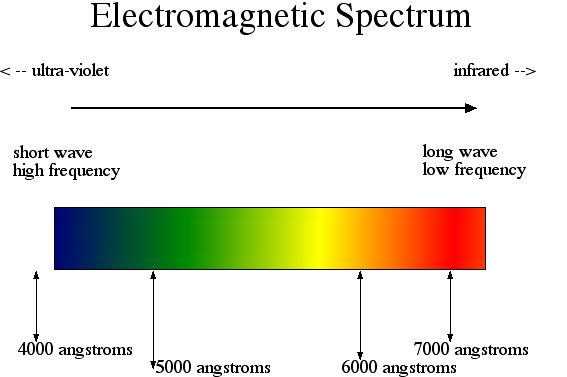
"Another remarkable universal law is that of gravitation, Isaac Newton developed the first version, which was followed 2.5 centuries by the more accurate general-relativistic gravitational theory of Albert Einstein." (85)
1665-1666
Newton in Woolsthorpe (to avoid the plague year in Cambridge & London.)
- refracting telescope
- prism & white
light comprised of refracted "colored" light bands
- integral and differential
calculus
- laws of motion
gravity is proportional to the mass & inversely proportional to the square of the intervening distance
| Modern universe is pictured by two complementary metaphors: | |||
| NEWTONIAN | vs. | RELATIVISTIC | |
• |
Newton's non relativistic cosmos | Einstein's relativistic universe | |
• |
principle of "action at a distance" | principle of equivalence | |
• |
space & time as absolute & separate | spacetime as intermixed | |
• |
Euclidean geometry | Non-euclidean Geometry of spacetime | |
• |
low relative velocities/ wide spaces | speed of light / nanometric spaces | |
• |
solar system bending of light | galactic & femto realms | |
• |
fixed, deterministic & measurable | statistical & stochastic, evolving | |
• |
mechanistic systems | complexly adaptive systems | |
• |
certainty & positivistic | uncertainty principle & indeterminacy | |
| example | example | ||
• when? |
1687 | 1905-1916 | |
![]() Newton's gravitational perspective, having been supplanted by a wholly different way to understand and interpret the world.
Newton's gravitational perspective, having been supplanted by a wholly different way to understand and interpret the world.
Einstein's curvature of spacetime by very massive or dense objects, required a new geometry:
Newton's Euclidean geometry & Einstein's non-Euclidean geometry
These new mathematical representations symbolize a change in worldviews or a what some experts call a
paradigm shift: "the replacement of an excellent theory by an even better one" (87)
See - Thomas Kuhn
Modernity or 1660s, and what's after modernity? The 1905-1916 quantum-relativistic world where the ferment of the femto universe seems at odds with the galactic cosmos because relativity and quantum mechanics give us two separate and distinct visions of reality.
Despite the irreconcilable relation of Einstein's and Bohr's views they produced
"a remarkably powerful schema, which has compressed into a brief message the general properties of gravitation everywhere." (88)"The schema is remarkably short, and its complexity is low. Hence, Einstein's general relativistic theory of gravitation is simple." (88)
G mu = 8pkT mu
(87)
Notes on the simple and the complex contrasts that reveal our vision

| depth of field comes from stereoscopic vision | simple | complex |
evolution
(time) |
||
ecology
(space) |
The Power of Theory
probing the ultimate secrets of the universe
But what a difference it makes when we see all existence as part of a pattern
"All around us are facts that are related to one another…. They
begin to make some sense. The world becomes a more comprehensible place."
Steps to depth of vision:
- see patterns
- identify regularities
- construct schemata
in our minds
sympathetic magic
"similar things must be connected" (89)
The dance of man mirrors the dance of the cosmos –
Shiva's dance of creation & destruction
theorizing in
the scientific manner about the world around us leads to seeing how connections
and working relationships fall into place.
(90)
Functional / structural / linguistic world we inhabit is our world
view or in the German weltanschauung.
| Gestalt psychology terms | weltanschauung is layered | scientific idiom |
| eigenwelt | personal reality | Id & ego, familiar {family} |
| mitwelt | shared reality | bio social animals |
| umwelt | underlying reality | biophysical |
90)
Theory is used in 2 quite distinct ways
![]()

Convention: math,
physics, chemistry, physiology, biology… { ? } (107)
real relationships: positivism & the problem of changes in worldviews
Comte (108)
math -- the logical consequences of of certain sets of assumptions (axioms)
fundamental quality of mathematical equations (109)
"We are thus led to the common metaphor of different levels of science,
with the most fundamental at the bottom and the least fundamental at the
top."
(111)
"They form part of a single connected structure. The unity of that structure is cemented by the relationship of those parts."
(112)
"The enterprise
of science involves investigating those laws at all levels, while also
working, from the top down and from the bottom up, to build staircases
between them."
"results of accidents that occurred early in the history of life on the planet."
(114)
"…whether biochemistry depends in an important way on history." (115)
"The Laws of biology do depend on the laws of physics and chemistry,
but they also depend on a vast amount of additional information about
how those accidents turned out." (115)
"The science of biology is very much more complex than fundamental physics because so many of the regularities of terrestrial biology arise from chance events as well as from the fundamental laws." (115)
"One of the great challenges of contemporary science is to trace the mix of simplicity and complexity, regularity and randomness, order and disorder up the ladder from elementary particle physics and cosmology to the realm of complex adaptive systems….such as living organisms." (119-120)
"To do this we have to examine fundamental physics from the point of view of simplicity and complexity and ask what role is played by the unified theory of the elementary particles …… (120)
![]()
"The universe consists of matter, and matter is composed of many different kinds of elementary particles, such as electrons & photons." p. 123.
The fundamental laws are subject to the principles of quantum mechanics, and at every stage of our thinking we will have to refer to the quantum approach."
"The discovery of quantum mechanics is one of the greatest achievements of the human race, but it is also one of the most difficult for the human mind to grasp, even for those of us who have used it daily in our work……It violates our intuition --- or rather our intuition has been built up in a way that ignores quantum mechanical behavior."
"why [does] our intuition seems to pay no attention to something so important (fundamental)?"
123
every electron in the universe is identical . . . all photons are likewise interchangeable."any particle can occupy an infinite number of different 'quantum states.'"
Fermions, electrons exclusionary rule particles occupy discrete spaces
Bosons, photons are anti-exclusionary wavelengths of emitted energy124
matter and energy are two sides of the same coin -- currency of the quantum realm
waves and particles are descriptions of the same thing based on different probes
Standard Model of "all known elementary particles"
has several flaws:1: three (or four) forces have very similar forms and cry out for unification
2: the model is not yet simple enough -- describes sixty fundamental particles
3: the model contains more than a dozen arbitrary constants describing a number
of interactions among the various particles.
4: gravitation is not included 125(126)
- magnetism (1600s)
- electricity (1800s)
- electromagnetism (1876)
- nuclear forces:
- weak (1898) radioactivity or radioactive decay
- strong (1930) binding energy of the atomic nucleus;
curve of binding energy
meta [in addition to or beside the atomic] nuclear forces there are:
- gravity (discovered in1689 & re-examined in 1916)
- electro-weak (discovered in the 19th and 2oth centuries & unified in the 1980s)
Einstein's misdirected focus on electromagnetism & gravity to the exclusion of quantum mechanics -of which he was skeptical.
127
Superstring Theory may be able to accomplish the unification of the three forces:
FORCE descriptive qualities from empirical quantities Where?
- gravity is mass warping space that holds the universe steady macro-everywhere
- electro-weak is radioactive decay of atomic nuclear quarks micro-ubiquity
- strong nuclear binds the sub-atomic like charged particles: protons or nucleons now understood as three quarks together at -10th to -15th of a meter scale
***"In particular, 'heterotic superstring theory' is the first viable candidate ever for a unified quantum field theory of all the elementary particles and their interaction."
128
"the old saw about the person who could pull themselves up by their own bootstraps."
"Such a particle system, if it exists, gives rise to itself." self actuating & maintaining
